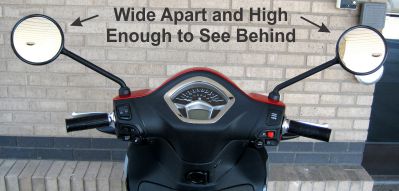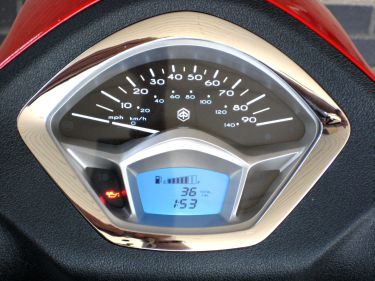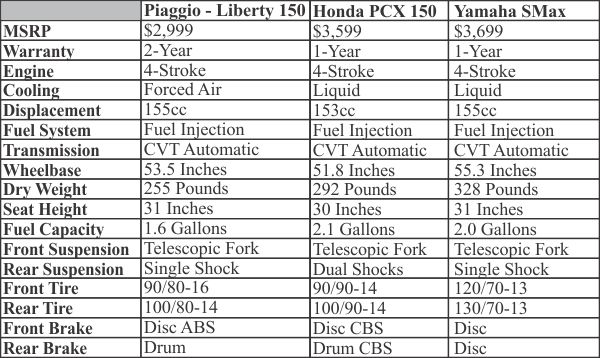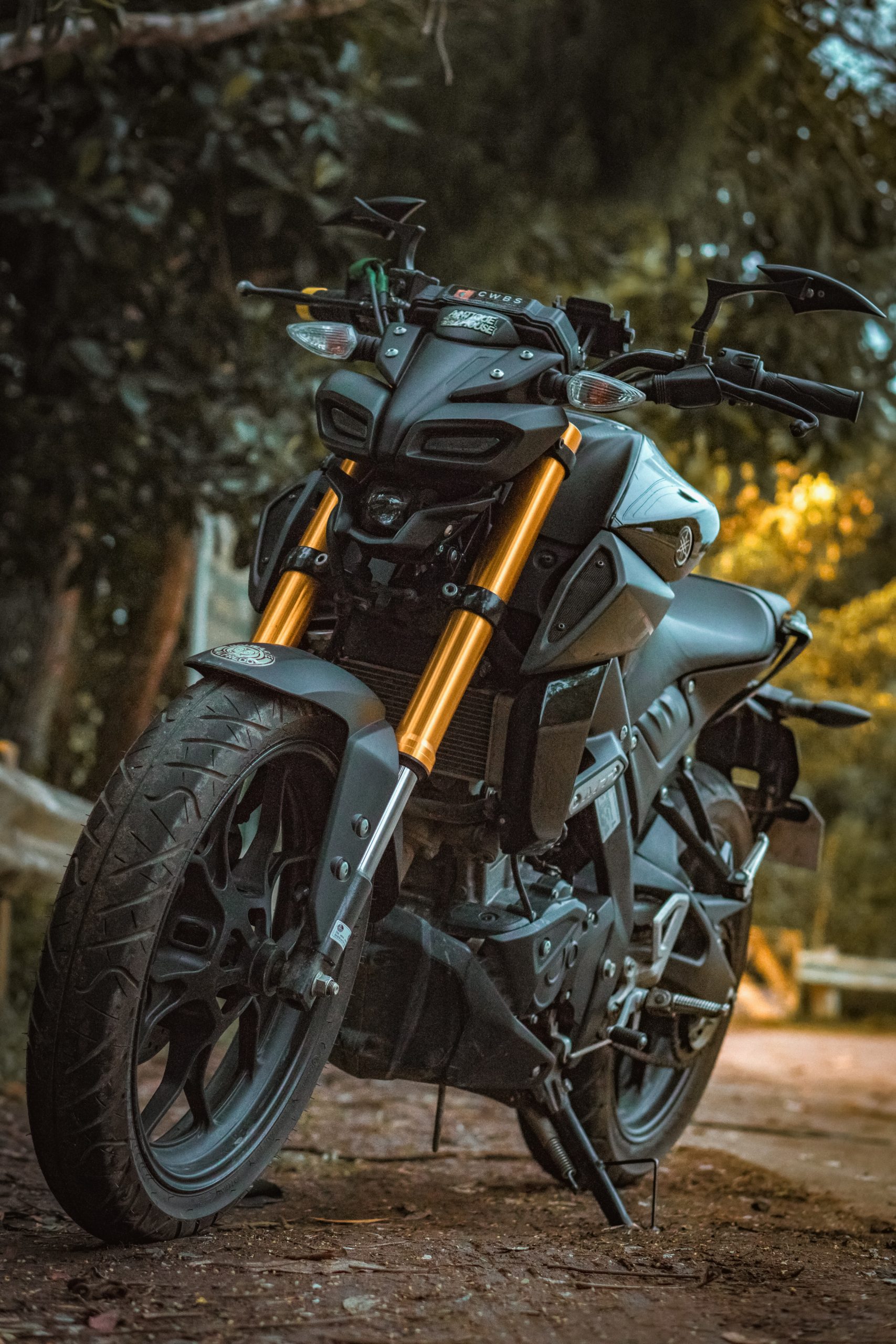 May, 2017
May, 2017
Our first scooter review of 2017 and it’s a…. Piaggio. It’s been nearly five years since I first reviewed the Piaggio BV350 and I’m still struggling with accepting Piaggios as “good” scooters. In several cases, even “great” scooters. For quite a while back in the day Piaggio scooters were (in my opinion) poorly made, not very reliable, and given little to no support in North America from the parent company. The fact that it has taken me so long to accept the much higher quality and improved support shows just what a curmudgeon I really am.
The new (to North America) Piaggio Liberty 150 is a wonderful machine. I tried my best to find things wrong with it and all I could come up with is a kind of weak horn. Most OEM scooter horns are pretty lame, and the Liberty 150 is no exception. Oh yes, it was also a bit of a reach for me to the controls, but I have normal length arms and a long torso. That’s not so much an issue with the scooter as it is just one of the many reasons I can find virtually no off-the-rack clothing that fits me.
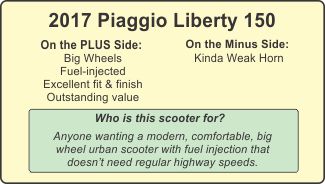
Speedometer Reading/Speed/Fuel Economy
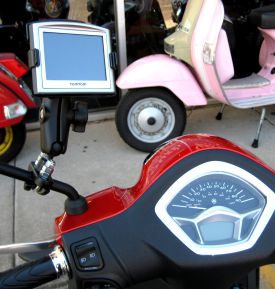
Like most scooters we review, the Piaggio Liberty 150 reads optimistically. The speedometer indicates 10% faster than actual speed. An indicated 30 MPH is actually 27 MPH and an indicated 50 MPH is actually 45 MPH. The odometer was very close to spot on. My 11.1 mile trip to the office (GPS verified) indicated 11.1 on the odometer. This was a brand new scooter that was NOT yet broken in. I expect that both top speed and fuel economy would improve after engine break-in. With some more miles on the Liberty 150 AND a rider who DOESN’T weigh 220 pounds, I would expect top speed and fuel economy to improve. Piaggio claims the Liberty 150 has a top speed of 61 MPH and gets 94 MPG. The fastest GPS speed I saw was 59 MPH so 61 MPH is certainly a possibility. I managed 92 MPG during the review which I consider to be very good. That’s right, 92 MPG on a new scooter carting my massive backside around. Hmmmm, maybe Piaggio’s claim of 94 MPG is…. conservative?!?!?
Features
We’ll get to the basics of the Piaggio Liberty 150 in a bit, but let’s start with some of the well thought out features including the reason to NOT put the keys in the glove box.
The mirrors are on long enough stems to allow a wide-load such as myself to see what’s going on behind me. They are also high enough to allow an excellent field of view. This is, sadly, not the case with many scooters. Moving down to the dash we see a clean and simple display with a “fan” speedometer display that is biased to miles for those of us in North America who can’t understandwhy one ten-thousandth of the length of a quadrant along the Earth’s meridian through Paris, that is the distance from the equator to the north pole, is utilized as a standard measurement by the rest of the world. 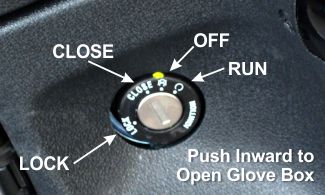
Let’s jump down to the ignition switch. In the scooter world we’re mostly used to three position switches: lock, off and run. Lock is furthest anti-clockwise and one generally turns the steering left. The steering locks and the key comes out. The key also comes out in the off position. When the ignition switch also does duty as a push-button opener for a glove box, this presents a potential issue. If you left the switch in the off position, took the key and went off for some coffee and a biscuit, someone could still open your glove box and likely access the underseat storage as well. On the Piaggio Liberty 150 the key DOES NOT come out of the switch in the off position, it only comes out in the close and lock positions. If one is used to tossing one’s scooter key in the glove box while one sits nearby enjoying that coffee and biscuit(s), one is going to be in trouble with the Liberty. The glove box opens with a push of the switch in the off position, but it is necessary to turn the switch to the close position to extract the key. Turn scooter off, push to open glove box, turn to close to extract key, toss aforementioned key in glove box and close door.
Did I mention that the Liberty 150 also has a powered seat latch release? Yes, it does, just like its big brother the BV350. It’s just there on the left hand control. Also a departure from the norm is the mode button on the right hand control. It’s used for changing out the mode of the digital display as well as adjusting the display and switching from miles to kilometers. These tasks involve various states of the ignition switch and holding, pressing quickly, and pressing and holding of the mode button. Consult the owner’s manual for specifics.
The Piaggio Liberty 150 is powered by a 150cc air-cooled and fuel-injected, single over-head cam three-valve single cylinder engine that generates about 13 horses and 10 foot-pounds of torque. It gets power to the rear wheel through a CVT automatic transmission. Brakes are anti-lock disc front and drum rear. This is a proper anti-lock system with a sensor ring on the wheel. The front tire is a 90/80 16 incher and the rear tire is a 100/80 14 incher. The rear suspension is a single pre-load adjustable shock absorber.
Storage is pretty decent with a glove box and luggage hook on the inside of the front legshield. The glove box is roomier than some, likely because the battery is located under the seat as opposed to front legshield as is the case with the Piaggio Fly 150. I did hang a cloth grocery bag with about five pounds of stuff in it from the luggage hook and it held the load just fine. There is an adequate “bucket” under the seat along with the fuel filler and a compartment for the battery. A full-face helmet wouldn’t fit, but my XXL three-quarter helmet DID fit. There are color-matched topcases available through your local Piaggio dealer. I believe they are priced in the low $200s and would certainly add to the practicality of the Liberty 150. There is a very small rear rack and passenger grab rails. The grab rails extend far enough forward to make them very functional for a passenger or as anchor points to bungee something on the passenger seat. Assuming that the seat is unoccupied of course.

Riding Impressions
Let’s get the Piaggio Liberty 150 on the road. In goes the key (in the close position) and one click clockwise brings us to the off position. I open the glove box a few times – just for fun – and then one more turn clockwise places us in the run position. I can hear the fuel pump doing its thing. Grabbing a brake lever I press the start button and the Liberty springs to life. It seems to search for an idle speed for a moment or two and settles into a smooth (for a single cylinder engine) cadence. There is no balking or hesitation as I pull out of the Scooterville parking lot and onto the road to run top off the tank with fuel and begin my testing. Have I mentioned before how much I love fuel injected scooters? Yes? Every damn time I open my mouth? Sorry, after so many decades of cantankerous carburetors you’ll have to allow me to revel in the joys of a good fuelie.
Ergonomics of the Liberty 150 are very good. The seat is roomy and comfortable, the legroom is good and the riding position was quite nice with just the tiniest bit of a reach for the controls. I didn’t feel I was leaning forward too far, but the reach is just not as perfect as, oh, say, a Vespa GTS. My long-suffering wife Beverly and I rode around a good bit on the Piaggio Liberty and her Honda PCX 150. I hate the OEM seat on the PCX. At first, I only disliked it, now I despise that ridiculous added “hump” just at the pilot’s tailbone. The smooth seat of the Liberty felt MUCH better. The PCX also has a tall center tunnel which limits potential foot positions. Something the true step-through Liberty doesn’t suffer from. I did like the control position of the PCX better, but I would give the overall ergonomics nod to the Liberty.
Masochists who have thoroughly familiarized themselves with JustGottaScoot will know that I like big-wheeled scooters. There are general differences inherent in the handling of small wheel (typically 10 inch) and big wheel (14 to 16 inch) scooters. Without digressing into gyroscopic precession, head angle, trail, rake and other elements, I’ll just say that bigger wheeled scooters tend to be more stable, especially at speeds about 35MPH or so. I’ve spent a bit of time riding The Liberty’s stablemate, the Piaggio Fly 150. They are similar machines, but the Fly rides on 12 inchers front and rear with a 52 inch wheelbase. The Liberty has a 54 inch wheel base and a 16 inch front and 14 inch rear tires. Side-by-side the Fly feels quicker to turn and more nimble, but less stable and smooth especially as the speed increases. The Liberty is certainly responsive in its handling, it just takes a touch more effort to turn than the Fly. The Liberty also soaks up road flaws better than the Fly. The front anti-lock disc brake and rear conventional drum work quite well on the liberty. Modulation was easy, I couldn’t lock up the front, but it felt more than strong enough right up to the point of locking. Most riders will not even notice the ABS brakes (other than the dash indicator light) unless they encounter a hard stop in a low traction situation. Then they will likely be quite happy to have ABS on their scooter. Again, comparing the Liberty and the PCX, I noticed that the PCX responded quicker to my inputs but the Liberty held a line better after slightly more effort to initiate the line. I also felt less of a rough road through the Liberty than I did on the PCX.
If I could clone two more of myself (an action specifically prohibited as a potential crime against humanity) and ride a Piaggio Liberty, Fly and Honda PCX at the same time I would likely find that the PCX was slightly quicker off the line and the Liberty was overall faster with the Fly right in the middle. The differences in quickness and top speed are not great between them. The real sweet spot for a good fuel injected 150cc class scooter is in “fast” city speeds: 35MPH to 50MPH. The Liberty would be just about perfect for a surface street machine.
Fit & Finish
Not all that many years ago I found miss-matched fasteners, misaligned body panels and low quality plastic and operational components on Piaggios. Then came 2013 and the new generation fuel injected Fly 150. Since then, I have continued to be impressed with the design, component and manufacturing quality that Piaggio has shown. The body panel quality and fit on the Liberty is excellent. I went over the headset in some depth and found even seams and perfect alignment. Take a good look at the dash and you’ll see what I mean. Even the turn signal indicator switch works well (a previous sore spot on Piaggios and Vespas) and the components appear to be robust enough to last many years. The colored body panels are beautifully done. The seat stitching and seams are perfect. Jeez, you’d almost think I was describing a Honda.
Piaggio Liberty 150 vs. The Competition
I’ve selected the Honda PCX 150 and Yamaha S-Max as comparisons for the Piaggio Liberty 150. I’ve reviewed the PCX and I own one. I have not ridden the Yamaha S-Max. The Piaggio Liberty 150 is, by far, the best deal. I like the liquid cooling of the Honda and Yamaha, but not enough to justify the price difference. If I were buying a scooter of this type today I would get the Liberty UNLESS I did not have easy access to a good Piaggio dealer. That’s one of the advantages that the Japanese brands still hold in North America – their dealer networks. A good dealer and good support are critical to a good scooter ownership experience. If all you have available to you is Honda or Yamaha, you’d probably be just fine with the PCX or S-Max. If you like in the Twin Cities area of Minnesota you’re in luck. You can just run round to Scooterville and snap up a Liberty.
Another Opinion
Jonathan at Scooterville has been selling scooters and motorcycles for a long time. Rumor has it that he sold Fred Flintstone his first push-scooter. While I don’t always agree with Jonathan’s opinions, I respect what he has to say. According to Jonathan:
In the last 10 years, they (Piaggio) have brought us some fantastic looking and performing scooters that have a very appealing larger wheel, more and more storage, and quality I expect from Piaggio. The only hiccup was the brief 2008-2009 Fly made in china. After that disappointment they returned to bringing us some very usable scooters.
Those old two stroke typhoons and lt50s were great, and the LT 150 was no slouch either.
I think that secretly you still love Kymco big-wheelers, and have difficulty accepting that this bike CRUSHES the people 150 with a big wheel, fuel injection, AND ABS! And it is better looking! With a better seat! And it is only $400 dollars higher than the People was 10 years ago! This bike is a winner with the big wheel, get over your love affair with no-longer-offered Kymco models and come over to the Piaggio side. Genuine is still the best for smaller scooters, but Honda and Yamaha should look out, PIAGGIO is going to eat their lunch.
Fair enough, I HAD forgotten about some of the good older Piaggio two-strokes. If one looks at some other Piaggio brands, there was the excellent SportCity scooter line. I still disagree with Jonathan about some of the older BV line of scooters – I was not happy with their quality. That’s part of the fun of all this scooter nonsense, one can disagree with someone and still respect their opinion and perspective. Too bad politicians can’t figure this out.
Conclusions
Having recently added a Piaggio BV350 to my stable of scooters, I was looking forward to the Liberty 150. It appears that Piaggio is bringing us new products that are not only on par with Honda, Yamaha and other top tier companies, but doing it at a price point that represents an outstanding value. The Liberty 150 ran flawlessly and everything worked. It’s comfortable, looks great, and has big wheels. Fit for the rider is an important factor in selecting the right scooter. For something small, it’s still tough to beat a Genuine Buddy. Then there’s the Piaggio Fly 150 for those wanting something physically bigger than a Buddy but still smaller wheeled. Now we can add the Piaggio Liberty to the “right choice” category for those looking for an outstanding big-wheeled urban scooter.
Again, a big THANK YOU to Bob at Scooterville in Minneapolis for providing the scooter used in this review.
David Harrington

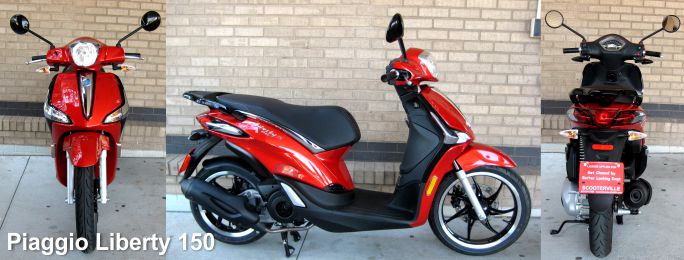
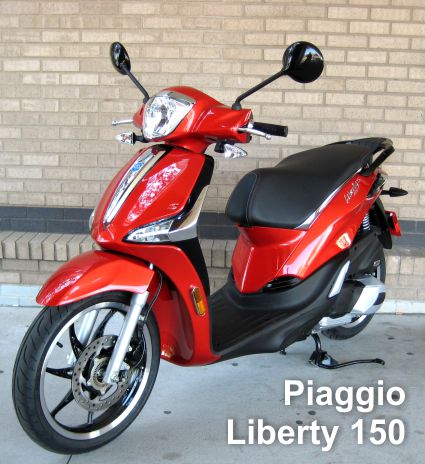 May, 2017
May, 2017